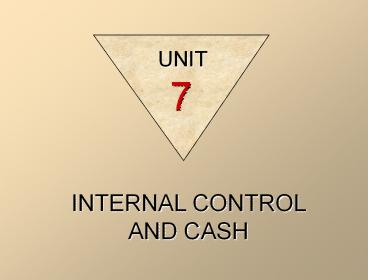Internal Control and Cash PowerPoint PPT Presentation
1 / 20
Title: Internal Control and Cash
1
UNIT
7
INTERNAL CONTROL AND CASH
2
INTERNAL CONTROL
- Internal control consists of the policies and
procedures adopted within a business in order to - 1. optimize resources, and
- 2. prevent and detect errors and
irregularities.
3
INTERNAL CONTROL
Internal control consists of the policies and
procedures adopted within a business in order
to 3. Safeguard its assets 4. Maintain the
accuracy and reliability of its accounting
records
4
ILLUSTRATION 8-1
PRINCIPLES OF INTERNAL CONTROL
- Authorization
- Segregation of duties
- Documentation procedures
- Safeguarding assets and records
- Independent verification
5
PRINCIPLES OF INTERNAL CONTROL
- Authorization of transactions and activities
Authorization by the proper individual is
important. Control is most effective when only
one person is responsible for a given task. - Segregation of duties The work of one employee
should provide a reliable basis for
evaluating the work of another
employee.
6
PRINCIPLES OF INTERNAL CONTROL
- Documentation procedures Documents should
provide evidence that transactions and events
have occured. - Safeguards to control access to, and use of,
assets and records Physical, mechanical, and
electronic controls relate primarily to the
safeguarding of assets and enhancing accuracy and
reliability of the accounting records.
7
PRINCIPLES OF INTERNAL CONTROL
- Independent verification
- External verification indicates whether the
companys financial statements fairly present its
financial position and results of operations in
accordance with GAAP. - Internal verification involves review,
comparison, and reconciliation of information
from two sources.
8
ILLUSTRATION 8-3 RELATIONSHIP BETWEEN
SEGREGATION OF DUTIES AND INDEPENDENT INTERNAL
VERIFICATION
Segregation of Duties
Accounting Employee A
Assistant Cashier B
- Maintains cash balances
Maintains custody
of per books
cash on hand
- Makes monthly comparisons reports any
irreconcilable differences to comptroller
Independent Internal Verification
Assistant Comptroller C
9
LIMITATIONS OF INTERNAL CONTROL
- Cost/benefit
- Collusion
- Size of business
- Human element
10
CASH
- Cash includes coins, currency, cheques, money
orders, and money on hand or on deposit at a bank
or similar depository. - Internal control over cash is imperative in order
to safeguard cash and assure the
accuracy of the accounting
records for cash.
11
CONTROL OVER CASH RECEIPTS
- Only designated personnel should be authorized to
handle or have access to cash receipts. - Different individuals should
- 1. receive cash
- 2. record cash receipt transactions
- 3. have custody of cash
12
CONTROL OVER CASH RECEIPTS
- Documents should include
- 1. remittance advices
- 2. cash register tapes
- 3. deposit slips
- Cash should be stored in safes and bank vaults.
- Access to storage areas should be limited to
authorized personnel. - Cash registers should be used in executing
over-the-counter receipts.
13
CONTROL OVER CASH RECEIPTS
- Daily cash counts and daily comparisons of total
receipts should be made. - All personnel who handle cash receipts should be
bonded and required to take vacations. - An important tool in control of over-the-counter
receipts is cash registers that are visible to
customers.
14
CONTROL OVER CASH DISBURSEMENTS
- Payments are made by cheque rather
than by cash, except for petty cash transactions. - Only specified individuals should
be authorized to sign cheques. - Different departments or individuals should be
assigned the duties of approving an item for
payment and paying it.
15
CONTROL OVER CASH DISBURSEMENTS
- Prenumbered cheques should be used and each
cheque should be supported by an approved
invoice or other document. - Blank cheques should be stored
in a safe. - 1. Access should be restricted to
authorized personnel. - 2. A cheque writer machine should be
used to imprint the amount on the cheque in
indelible ink.
16
CONTROL OVER CASH DISBURSEMENTS
- Each cheque should be compared with the approved
invoice before it is issued. - Following payment, the approved invoice should be
stamped PAID.
17
PETTY CASH FUND
- A petty cash fund is used to pay relatively
small amounts. - Operation of the fund, often called an imprest
system, involves - 1. establishing the fund,
- 2. making payments from the fund, and
- 3. replenishing the fund.
- Accounting entries are required when
- 1. the fund is established,
- 2. the fund is replenished, and
- 3. the amount of the fund is changed.
18
USE OF A BANK
- The use of a bank minimizes the amount of
currency that must be kept on hand and
contributes significantly to good internal
control over cash. - A company can safeguard
its cash by using a bank as
a depository and clearing
house for cheques
received and
cheques written.
19
REPORTING CASH
- Cash reported on the Balance Sheet includes
- 1. Cash on hand
- 2. Cash in banks
- 3. Petty cash
- Cash is listed first in the balance sheet
because it is the most liquid asset.
20
CASH EQUIVALENTS
- Cash equivalents are highly liquid investments,
with maturities of three months or less when
purchased, that can be converted into a specific
amount of cash. - Examples include money market funds, short-term
notes, and treasury bills.

